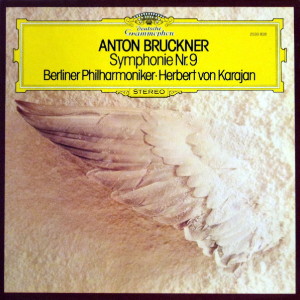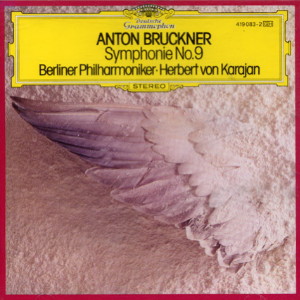 |
|
1 LP -
2530 828 - (p) 1976
|
 |
| 1 CD -
419 083-2 - (c) 1987 |
|
| ANTON BRUCKNER
(1824-1896) |
|
|
|
|
|
|
|
| Symphonie
Nr. 9 d-moll |
|
61' 04" |
|
| Versione
originale |
|
|
|
| -
1. Feierlich, misterioso |
24' 42" |
|
|
| -
2. Scherzo: Bewegt, lebhaft |
10' 36" |
|
|
| -
3. Adagio: Langsam, feierlich |
25' 46" |
|
|
|
|
|
|
| Berliner
Philharmoniker |
|
| Herbert von KARAJAN |
|
|
|
|
|
Luogo
e data di registrazione |
|
Philharmonie,
Berlino (Germania) - settembre
1979 |
|
|
Registrazione:
live / studio |
|
studio |
|
|
Production |
|
Dr.
Hans Hirsch, Magdalene Padberg |
|
|
Recording
Supervision |
|
Michel
Glotz |
|
|
Balance Engineer |
|
GŁnter
Hermanns |
|
|
Prima Edizione LP |
|
Deutsche
Grammophon - 2530 828 - (1 LP) -
durata 61' 04" - (p) 1976 -
Analogico |
|
|
Prima Edizione CD |
|
Deutsche
Grammophon - 419 083-2 - (1 CD) -
durata 61' 04" - (c) 1987 - ADD |
|
|
Note |
|
Cover
Design: Holger Matthies, Hamburg
|
|
|
|
|
In his essay
"The Symphony from Beethoven
to Mahler", which appeared
in 1918, Paul Bekker
distinguished between German
and Austrian symphonic
writing of the 19th century.
He attributed an
intellectual character to
German, but not to Austrian
symphonies, considering the
latter to be products of
undiluted romanticism, with
no intellectual basis.
Bekker's principal
conclusion in this respect
was that Austrian symphonic
music is a product of
romanticism entirely of the
senses, since all the ideas
clamouring to be expressed
are transformed into music
without any detour by way of
literary or programmatic
functions. He concluded, in
this connection, that
Bruckner carried on the
musical line of Schubert.
Anton Bruckner was certainly
not a composer of literary
orientation like Schumann,
or even Brahms.
Nevertheless, his sensuous
romanticism had motivation
of its own. In his Ninth
Symphony, he went further in
opening up hitherto
unexplored territory than in
any of his earlier works. It
cannot have been an urge for
novelty as an end in itself
which drove him in this
direction, but an elemental
creative wull beyond the
sphere of his senses,
influenced by metaphysical
concepts of existence. One
aspect of this work which
brings Bruckner close to
Schubert is its
incompleteness; like several
of Schubert's sonatas,
Bruckner's D minor Symphony
has no finale - it ends with
an Adagio. This
incompleteness - though it
was not Bruckner's intention
- leaves the listener with a
sense of nearness to death
and transcendence.
What may be experienced in
late Schubert (and
throughout Wagner) as a
longing for death appears in
Bruckner's Ninth Symphony as
preparedness for death - not
as a fatalistic insight into
what cannot be avoided.
Here, Bruckner stands before
us as a positive figure: a
devout man determined to
fight. The character of the
music, programmatic in the
wider sense, does away with
rigid boundaries between
component parts of the
structure, allowing for the
creation of freer formal
blocks which influence one
another, their inner
development clearly
resulting from the specific
characteristics of their
subject matter.
In the first movement,
Bruckner works with three
main themes and motive
material derived from them,
making use of only a very
free concept of sonata form.
The Scherzo is dominated by
diffuseness of the sound
picture, the scene being set
immediately by a dissonant
chord played by an oboe and
three clarinets. The key of
D minor is clearly
established only in the
enthralling string passage
to a stamping three-four
rhythm (bar 42), and even
then the tonality is quickly
obscured by harshly
conflicting dissonances. The
sense of anxiety and
disquiet engendered by this
movement is not dispelled by
its Trio in F sharp major,
and indeed becomes still
more pronounced as fleeting
wisps of sound and jagged
figures create in icy
atmosphere. In the Adagio,
Bruckner opens up broad
tonal expanses. Never before
did he so plunge into
apparent unreality - the
opening theme's initial leap
of a ninth at first gives no
clear indication of its key
centre. As the movement
proceeds, the
transfiguration of the
musical material is carried
to its conclusion. The
correctness of Bekker's
assertion is, however,
confirmed: here, without any
intellectual preconception,
Bruckner has entered into a
hitherto unknown area of
experience, with the aid of
his unshaken, unadulterated
romanticism.
Hanspeter
Krellmann
(Translation:
John Coombs)
|
|
|